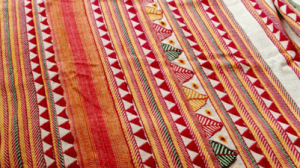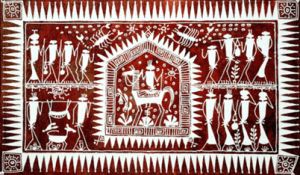TAG: GS 1: ART AND CULTURE
THE CONTEXT: Recently, seven products from Odisha, ranging from the Similipal Kai chutney made with red weaver ants to the embroidered Kapdaganda shawl, have bagged the coveted Geographical Indication (GI) tag in recognition of their exclusivity to the state.
EXPLANATION:
- Geographical Indications (GI) tags serve as markers of authenticity and distinctiveness for products, certifying their origin from a specific geographical location.
- In India, the Department for Promotion of Industry and Internal Trade, Ministry of Commerce and Industry, awards GIs.
- These tags offer assurance of quality, prevent product duplication, and safeguard the interests of local growers and artisans.
Seven Distinctive Products from Odisha with GI Tags
- Kapdaganda Shawl:
- Woven and embroidered by the women of the Dongria Kondh tribe, the shawl reflects the rich tribal heritage of the Dongria Kondhs.
- Dongria Kondh tribe is a particularly vulnerable tribal group (PVTG) in the Niyamgiri hills in Odisha’s Rayagada and Kalahandi districts.
- It is embroidered on an off-white coarse cloth with red, yellow and green coloured threads, with each colour holding significance.
- Green symbolises the mountains and hills, and yellow stands for peace and happiness. Red stands as the symbol of blood.
- The motifs in the shawls are mostly lines and triangles, believed to be a reflection of the importance of mountains for the community.
- The shawl is worn by both men and women and the Dongrias gift it to their family members as a token of love and affection.
- Woven and embroidered by the women of the Dongria Kondh tribe, the shawl reflects the rich tribal heritage of the Dongria Kondhs.

- Lanjia Saura Painting:
- The painting, one of the oldest tribal art forms, is also known as Idital.
- The artworks are famous for their beauty, aesthetics, ritualistic association and iconography.
- The art form belongs to the Lanjia Saura community, a PVTG largely residing in the Rayagada district.
- These paintings are in the form of exterior murals painted on the mud walls of homes.
- White paintings figure over a crimson-maroon background.
- It is believed that the Lanjia Sauras paint their walls with Idital artworks to show gratitude to their deities and forefathers, and also for the well-being of their community.
- Reflecting the love and affection of the primitive tribes for nature, they feature subjects like tribal humans, trees, animals, birds, the Sun and the Moon.

- Koraput Kala Jeera Rice:
- Renowned as the ‘Prince of Rice,’ this black rice variety from Koraput region offers aroma, taste, texture, and nutritional benefits.
- Preserved for around 1,000 years by tribal farmers.
- Its consumption aids in increasing haemoglobin levels and improving metabolism.
- Similipal Kai Chutney:
- A traditional delicacy made with red weaver ants found in Mayurbhanj forests, known for its medicinal and nutritional value.
- Rich in nutrients like protein, calcium, vitamin B-12, and iron.
- It is prepared by manually grinding the ants and is believed to enhance immunity.
- Nayagarh Kanteimundi Brinjal:
- Nayagarh Kanteimundi Brinjal is known for its prickly thorns on the stems and the whole plant.
- The green and round fruits contain more seeds as compared to other genotypes.
- It is famous for its unique taste and relatively short quick cooking time.
- The plants are resistant to major insects and can be grown with minimal pesticide.
- It is being widely cultivated in Nayagarh district of the state.
- The growers are getting a yield of up to 200 quintals per hectare and selling at around Rs 60 per kg.
- Historical records also suggest that the locals got the brinjal from the hilly areas. They collected seeds from it and started raising seedlings nearly 100 years ago.
- Odisha Khajuri Guda:
- Organic jaggery extracted from date palm trees in Gajapati district.
- Dark brown in color with a distinctive taste,
- It is shaped in a trapezoidal form called ‘Patali Gur,’ serving as a natural sweetener.
- Dhenkanal Magji:
- A cheese-based sweet made from buffalo milk with unique characteristics in appearance, taste, and nutritional value.
- Originating in Dhenkanal district, this sweet is prepared by draining moisture from cheese, frying, and forming balls.
Geographical Indications (GI) tags:
- GI tag is the abbreviation of Geographical Indications tags in India. It came into force with effect from 15th September 2003.
- A geographical indication (GI) is a sign used on products with a specific geographical origin and possesses qualities or a reputation due to that origin.
- This tag is valid for 10 years and can be renewed.
- Geographical Indications protection is granted through the TRIPS Agreement.
- The Geographical Indication Registry issues this tag under the Department of Industry Promotion and Internal Trade, Ministry of Commerce and Industry.
- Geographical indications are typically used for agricultural products, foodstuffs, wine and spirit drinks, handicrafts, and industrial products.
- The Gucchi mushroom, one of the most expensive mushrooms in the world, from the state of Jammu and Kashmir was recently given the GI tag in India.
Significance of GI Tags for Odisha Products
- These GI-tagged products showcase Odisha’s rich cultural heritage, traditional craftsmanship, and unique agricultural produce.
- The recognition not only assures authenticity and quality but also aids in preserving traditional knowledge, protecting local communities’ interests, and promoting these exceptional products on a national and global scale.
- The GI tags signify the exclusivity and significance of these goods, ensuring recognition and protection against unauthorized duplication or misuse, thus benefiting local artisans, growers, and consumers.

